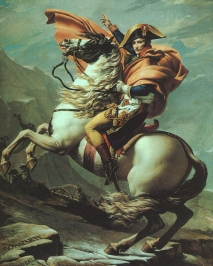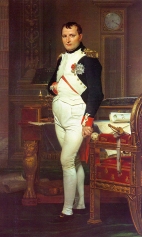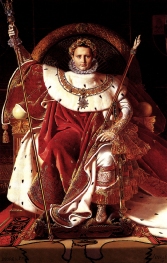The French Revolution and the Age of Napoleon |
The French Revolution and the Age of Napoleon |
Throughout history artists have often represented events of their times, sometimes objectively, sometimes with personal commentary. An earthshaking event like the French Revolution called forth the passions of many artists. No artist, however, rose to the challenge of these dramatic events as Jacques Louis David did. Although David's Oath of the Horatii was painted four years before the beginning of the French Revolution, it was later seen as no mere painted rhetoric (when men actually swore oaths and seized swords) and was widely interpreted as a patriotic call to arms, a reason it was exhibited again after the beginning of the Revolution.
Just as David's later works are no longer neoclassical in style, they also are no longer based on classical history, but respond specifically to contemporary events. David was himself a deputy at the Convention and voted for the death of King Louis XVI in 1793. He made speeches supporting the ideals of the revolution, reorganized the arts establishment in France, and designed everything from sabres to uniforms to funeral processions.|
Jacques-Louis David (1748-1825)
|
|
|
Napoleon Crossing the Alps 1800
|
|

|
Recall David's earlier Neo-classical paintings like The Oath of the Horatii. This work is the antithesis of the sober moral narratives of David's earlier career. Here the painting is Baroque in style with an idealized and heroized Napoleon on a glorious rearing steed (when in reality he rode a mule!). This became the prototype of all Napoleonic portraits to come--and indeed the prototype for aggrandizing military leaders. Here the Corsican upstart is also given a grand historical pedigree; the rocks in the foreground have the names Hannibal, Karolus Magnus (Charlemagne), and Bonaparte. |
|
Jacques-Louis David (1748-1825)
|
|
|
Napoleon in his Study 1812
|
|

|
Unlike the portrait of the aggrandized military leader, this realistic picture depicts the slightly balding, puffy-faced leader at work for the Empire. Although he is still in the parade uniform of a general, the hour marked on the clock (4:13 a. m.), the candles burnt to their sockets, and the scattered papers tell the viewer that the Emperor has just risen from his desk. The rolled paper on his chair says "COD..." for the Civil Code (or Code Napoléon--see Spievogel, page 425)--a tribute to Napoleon's role as an administrator. |
|
Jean-August-Dominique Ingres (1780-1867)
|
|
|
Napoleon on the Imperial Throne 1806
|
|

|
David was not the only French artist to glorify Napoleon. Like David's depiction of the revolutionary martyr Marat, Ingres's aggrandizement of the Emperor follows medieval traditions, in this case the picturing of God the Father. (See, for example, the representation of God at the top center of the Ghent altarpiece, part of the French war booty, exhibited in Paris in the early nineteenth century.) Napoleon wears sumptuous coronation robes (he was crowned in 1804) and holds the sceptre of Charles V and the hand of justice of Charlemagne--historical allusions to bolster his legitimacy. Steps lead up to his throne, the back of which forms a kind of halo above his head. Napoleon revived other historical allusions--the imperial eagle of Rome (on the carpet at his feet) and the bees (on his robe), a symbol of industry. |
All images marked MAS were photographed on location by Mary Ann Sullivan. All other images were scanned from other sources or downloaded from the World Wide Web; they are posted on this password-protected site for educational purposes, at Bluffton College only, under the "fair use" clause of U.S. copyright law.